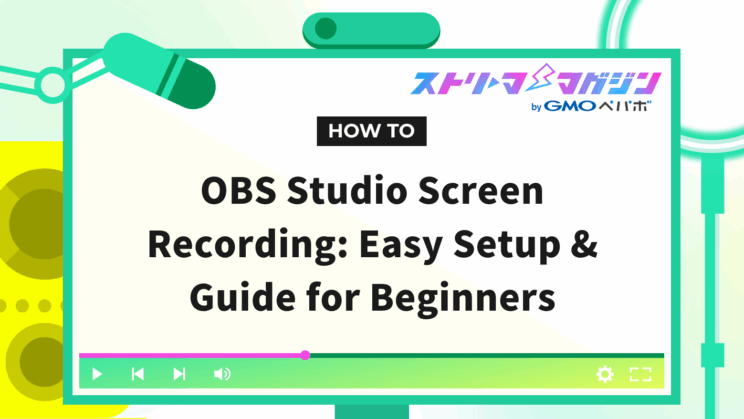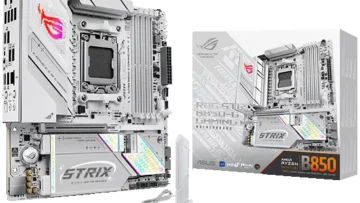OBS Studio Screen Recording: Easy Setup & Guide for Beginners

Index
- OBS Studio Allows Free Screen Recording
- Guide to Setting Up for Screen Recording with OBS Studio!
- Procedure 1: Add Scenes and Sources: Choose What You Want to Record
- Window Capture
- Screen Capture
- Game Capture
- Video Capture Device
- Procedure 2: Set Up Audio! How to Record Microphone and PC Audio
- How to Record Desktop Audio (PC Audio)
- How to Record Microphone Audio
- How to Record Audio from Specific Applications (OBS Studio Version 28.0 or Later)
- Adjusting Audio Balance
- Procedure 3: Set Output Settings Such as Save Location, File Format, and Quality
- Setting the Save Location
- Setting the Recording Format
- Setting the Quality
- Let’s Try Screen Recording with OBS Studio!
- Tips to Enhance Screen Recording Efficiency with OBS Studio
- Common Issues and Solutions with Screen Recording in OBS Studio
- Conclusion
OBS Studio is a free, high-performance screen recording and streaming software used for game streaming, live broadcasting, and video content creation in various scenarios.
This article will explain clearly for beginners how to use OBS Studio from the basics, techniques for making recordings more convenient, and troubleshooting.
OBS Studio Allows Free Screen Recording
OBS Studio is open-source software available for free. It offers not only streaming but also high-performance screen recording features.
Commonly, free screen recording software has limitations on recording time and quality, but OBS Studio does not have such restrictions. Its appeal lies in its rich set of features necessary for video creation, despite being free.
| Features | OBS Studio |
|---|---|
| Recording Time | Unlimited |
| Quality | Supports High Quality |
| Recording File Formats | Supports Various Formats |
| Supported OS | Windows, Mac, Linux |
| Audio Recording | Flexible settings such as microphone and PC audio |
| Other Features | Advanced features like scene switching and hotkey settings |
Furthermore, OBS Studio is not just limited to screen recording. It offers extensive audio settings to record microphone and PC audio separately or mix multiple audio sources. It also boasts advanced features such as scene switching and hotkey settings, providing multifunctionality that defies its free status.
In addition, output settings can be finely adjusted, allowing customization of save formats and bit rates. It is available for use not only on Windows but also on Mac and Linux, making it accessible for a wide range of users.
OBS Studio is a highly recommended tool for all users, from beginners who want to start video production to advanced users who want serious streaming and recording.
Guide to Setting Up for Screen Recording with OBS Studio!
Procedure 1: Add Scenes and Sources: Choose What You Want to Record
To record the screen with OBS Studio, it’s important to understand “Scenes” and “Sources.”
A Scene combines multiple sources. For example, if you want to record both the game screen and the webcam video simultaneously, you can combine them into one scene.
A Source refers to the actual target you want to record. You can select various sources like the game screen, webcam video, and desktop screen.
To start screen recording in OBS Studio, first create a “Scene.” Click the “+” button and give it an easy-to-understand name. It’s recommended to name it according to its use, such as “Game Streaming” or “Chatting Broadcast.”
Next, add “Sources” to the created scene. There are various types of sources, but here we’ll introduce four typical ones.
- Window Capture
- Screen Capture
- Game Capture
- Video Capture Device
Window Capture
You can specify a particular application window to record. This is ideal if you want to narrow down the range to record certain things like browsers, apps, or software. Use this if you want to avoid showing unnecessary information.
Screen Capture
This records the entire desktop screen. It’s convenient when you want to record the entire screen, such as when displaying multiple application windows simultaneously.
Game Capture
This source is specialized for recording PC game screens. It allows settings for high-quality and high-frame-rate recordings, making it ideal for creating game commentary videos.
Video Capture Device
You can import video from external devices such as capture boards connected to the PC. This is used when you want to record video from devices other than the PC, such as game consoles or cameras.
In OBS Studio, you can combine these sources for various recording settings. For example, if you want to record the game screen and webcam video simultaneously, add both game capture and video capture device to the same scene. Additionally, if you wish to add your commentary to the game screen, you can also include microphone audio.
After adding sources, adjust the recording area and volume. With screen capture or game capture, you can adjust the recording area. You can also adjust the volume balance of each source.
Procedure 2: Set Up Audio! How to Record Microphone and PC Audio
It is crucial to record the audio when recording with OBS Studio. This section explains how to record either microphone audio or PC audio, or how to select and record only specific audio.
How to Record Desktop Audio (PC Audio)
To record audio output from the PC, follow these steps:
- Select “File” > “Settings” > “Audio” from the OBS Studio menu bar.
- In the “Desktop Audio” section, select the audio output device to use. Generally, “Default” should work fine, but if you’re using a specific audio interface, choose the appropriate device.
- Click “OK” to save your settings.
After setting, play music on the PC and check that the audio level in the OBS Studio audio mixer fluctuates. If it fluctuates, desktop audio is being input correctly.
How to Record Microphone Audio
To record audio from the microphone, follow these steps:
- Select “File” > “Settings” > “Audio” from the OBS Studio menu bar.
- In the “Mic Audio” section, select the microphone you want to use.
- Click “OK” to save your settings.
After setting, speak into the microphone and ensure that the audio level in the OBS Studio audio mixer fluctuates. If it fluctuates, the microphone audio is being input correctly.
How to Record Audio from Specific Applications (OBS Studio Version 28.0 or Later)
In OBS Studio version 28.0 or later, you can choose to record only the audio of specific applications. This allows settings such as recording only the game audio while excluding Discord voice chat.
The setup process is as follows:
- Select “File” > “Settings” > “Audio” in the OBS Studio menu bar and set “Desktop Audio” to “Disabled”.
- In the OBS Studio Sources dock, click the “+” button and select “Application Audio Capture”.
- In the settings screen, select the application from which you want to capture audio.
- Click “OK” to save your settings.
After setting, output audio in the selected application and confirm that the audio level fluctuates in the OBS Studio audio mixer. Simultaneously, confirm that audio from applications you don’t want to record does not cause a reaction in the mixer. With this, the settings to record only audio from specific applications are complete.
Adjusting Audio Balance
After the above settings, perform a test recording and adjust the audio balance between desktop and microphone audio. You can adjust the audio balance by operating the audio sliders for each source in the OBS Studio audio mixer.
Procedure 3: Set Output Settings Such as Save Location, File Format, and Quality
When recording with OBS Studio, it’s crucial to appropriately configure output settings like the save location, file format, and quality to suit post-editing and video usage.
First, click the “Settings” button in the lower-right corner of the main OBS Studio screen and open the “Output” tab. Various output settings can be configured within this tab.
Setting the Save Location
You can set the save location in the “Recording Path.” By default, it is set to “C:\Users\(PC Username)\Videos,” but you can change it to any folder. If saving large video files, you might specify an external HDD.
Setting the Recording Format
Next is setting the recording format, where you choose the file format for the video. It is recommended to select the widely used MP4 format. MP4 is highly compatible with many devices and video editing software, making it easy to handle.
The initial setting is “mkv,” so you need to change it to save in widely used mp4 format. Choose your desired file format under the “Recording Format” in the “Recording” section within the “Output” tab on the settings screen.
Other formats like flv, mkv, mov, ts, etc., can be selected, but if focusing on compatibility, mp4 is the best choice.
For a detailed explanation on how to record in MP4 format with OBS, including how to convert from MKV, check out the article below.
How to Record in MP4 with OBS: A Complete Guide Including MKV Conversion
Setting the Quality
Quality settings are handled in the Encoder settings. After setting the output mode to “Advanced,” select the “Recording” tab and choose from the “Encoder.” For software encoders aimed at x86/x64, x264 is recommended. Choosing hardware encoders like NVENC or Quick Sync Video can reduce the load on the CPU.
| Encoder | Description | Load | Quality |
|---|---|---|---|
| x264 | Software encoder using CPU | High | High |
| NVENC | Hardware encoder using NVIDIA GPU | Low | Medium |
| Quick Sync Video | Hardware encoder using Intel GPU | Low | Medium |
For rate control, you can choose from CBR, VBR, or CQP. CBR is encoding at a constant bitrate, offering stable quality. VBR varies bitrate based on scenes, keeping file size small. CQP keeps constant quality and is suitable when focusing on quality.
| Rate Control | Description | File Size | Quality |
|---|---|---|---|
| CBR | Constant bitrate | Large | Stable |
| VBR | Variable bitrate | Small | Variable |
| CQP | Constant quality | Medium | Stable |
AAC is the recommended audio encoder. AAC pairs well with mp4 format and balances well between sound quality and file size.
Choosing the best settings tailored to the video’s purpose and your PC’s specs is crucial. For example, if aiming for high-quality recording, select x264 for the encoder and CQP for rate control. Conversely, if file size is a concern, choose NVENC or Quick Sync Video for the encoder and VBR for rate control.
Let’s Try Screen Recording with OBS Studio!
Once you complete the recording settings in OBS Studio, it’s time to start recording. Try recording with the settings you’ve configured to ensure the screen and audio are captured correctly.
To start recording, click the “Start Recording” button at the lower-right corner of the OBS Studio screen. Recording will commence immediately upon clicking this button.
| Item | Description |
|---|---|
| Start Recording | Click the button at the lower-right of the OBS Studio screen |
| Stop Recording | Similarly, click the “Stop Recording” button |
| Verify Recording | Open the save folder from “Show Recordings” |
To stop recording, click the “Stop Recording” button displayed in the same location. Although recording time is unlimited, ensure to stop the recording as needed.
Also, verify where the recorded file is saved. To check, select “File” from the OBS Studio menu bar and click “Show Recordings.” This will automatically open the folder where the recorded files are saved.
When recording for the first time, pay special attention to the following points during the test recording.
- Audio: Ensure the microphone and PC audio are recorded correctly
- Screen: Check if the recording area is appropriate without any unnecessary items included
- Quality: Verify the recording quality matches the settings
If there are no issues during the test recording, proceed to full-scale recording. If there are problems, review the settings and conduct another test recording.
Also, ensure that the recorded file is saved correctly in mp4 format. If you want to save in a different format, you can change it in the output settings.
OBS Studio allows you to pause and resume recordings. If you need to pause during recording, click the “Pause Recording” button. To resume, click the same button again.
For instructions on how to check or change where OBS saves your recordings, take a look at the article below.
Where Does OBS Save Recordings? How to Check, Change, and Configure Save Locations
Once you become accustomed to recording, why not focus on the visual impact? With the distribution screen design service “Alive Studio,” you can easily create a broadcast layout that reflects your style.
Tips to Enhance Screen Recording Efficiency with OBS Studio
When conducting screen recordings with OBS Studio, utilizing certain features can make operations more efficient. Here, we’ll discuss hotkey settings for simplifying recording operations, utilizing the pause and resume feature for recordings, and smoothly switching using multiple scenes.
Use Hotkey Settings to Simplify Recording Operations
In OBS Studio, setting hotkeys lets you execute operations like starting and stopping recording simply by pressing designated keys on your keyboard. This eliminates the need to use the mouse, allowing you to operate smoothly without missing the timing of recording start.
To set up, open the “Hotkeys” tab in the settings screen and assign arbitrary keys. For instance, you can assign “Ctrl + Shift + R” to “Start/Stop Recording,” enabling the start and stop of recording at the press of a button.
| Operation | Hotkey Example |
|---|---|
| Start/Stop Recording | Ctrl + Shift + R |
| Pause/Resume Recording | Ctrl + Shift + P |
| Scene Switch | Ctrl + Number Key |
Utilize the Pause and Resume Feature for Recordings
OBS Studio comes equipped with a pause and resume recording feature. By using this, you can cut unnecessary parts during recording or pause and resume recording later. This reduces the effort needed for video editing, making recording proceed efficiently.
Just like with starting and stopping, you can set hotkeys for pause and resume. For instance, by setting “Ctrl + Shift + P” for “Pause/Resume Recording,” it becomes operable with a single touch.
Use Scenes To Seamlessly Switch Recordings
By utilizing the scene function in OBS Studio, you can pre-set multiple screen configurations and switch smoothly during recording. For example, if you set game screens and webcam videos as separate scenes, you can switch between them with a single button.
You can also set hotkeys for scene switching. For instance, if you set “Scene 1” to “Ctrl + 1” and “Scene 2” to “Ctrl + 2,” you can seamlessly switch them instantly.
By leveraging these functions, you can conduct screen recording with OBS Studio more efficiently. Use these functions appropriately according to the situation to build a comfortable recording environment.
Common Issues and Solutions with Screen Recording in OBS Studio
While OBS Studio is a convenient screen recording software, some issues may arise during use. Here, we explain common issues and their respective solutions.
Solutions If Audio Isn’t Recorded
If the audio isn’t recorded, check the following items:
| Checkpoints | Details |
|---|---|
| Mute Confirmation | Check if OBS Studio, the OS, the microphone, speakers, etc., are muted. |
| Device Selection | Ensure the correct audio input and output devices are selected. In OBS Studio’s settings, verify in the “Audio” section that the microphone and speakers are recognized correctly and the appropriate device is selected. |
| Volume Level Check | Confirm that both OBS Studio and the OS volume mixer levels are appropriately set. |
| Driver Updates | Ensure audio drivers are up to date. Using outdated drivers may result in improper audio recording. |
| Application Audio | If specific application audio isn’t recorded, ensure the OBS Studio version is 28.0 or later and confirm that application audio capture is correctly set. |
Solutions If Recording Is Choppy
If recording feels choppy or frames are dropping, confirm and adjust the following items:
| Adjustment Checklist | Details |
|---|---|
| Review Encoder Settings | If using x264 encoder, change the preset to a faster setting. Trying “veryfast” or “ultrafast” settings can reduce CPU load. If NVIDIA NVENC or AMD AMF hardware encoder is available, using those can also be effective. |
| Resolution and Frame Rate Adjustment | Lowering the output resolution and frame rate can reduce the load on the PC. If recording full HD (1920×1080) at 60fps, you might change to 720p (1280×720) at 30fps, adjusting as needed. |
| Reducing PC Load | Closing other applications during recording and stopping unnecessary background processes could reduce PC load, resulting in smoother recording. |
If the issue persists, be sure to check out the article below for quick fixes.
Fix Choppy OBS Recordings Instantly: A Complete Guide to Causes and Solutions
Solutions If the Screen Goes Black
If the screen goes black, check the following items:
| Verification Items | Details |
|---|---|
| Source Verification | Ensure that sources like screen capture and window capture are correctly set. |
| Game Capture Settings | If using game capture, confirm the game is being correctly recognized and the appropriate capture mode is selected. |
| Administrator Privileges | Running OBS Studio with administrator privileges can sometimes allow capturing certain games or applications. |
| Graphics Settings | The graphics settings of games or applications might conflict with OBS Studio. Consider changing the game’s graphics settings or adjusting the compatibility settings of OBS Studio. |
Conclusion
This guide has explained how to use OBS Studio for screen recording. OBS Studio is high-performance software, yet you can easily record by simply mastering basic operations. Edit and share recorded videos for various applications.
By editing and sharing videos created with OBS Studio, you can use them in presentations, tutorial videos, game commentary videos, and various other purposes.
The basic steps for recording settings in OBS Studio are as follows:
| Procedure | Settings | Description |
|---|---|---|
| Procedure 1: Add Scenes and Sources | Select what you want to record | Choose from window capture, screen capture, game capture, video capture devices, etc. |
| Procedure 2: Audio Settings | Record Microphone and PC Audio | Select and adjust desktop audio, microphone audio, specific application audio, etc. |
| Procedure 3: Output Settings | Set Save Location, File Format, and Quality | Configure save location, recording format, and quality. |
Launch OBS Studio and follow the steps above to perform the settings. Clicking the “Start Recording” button allows you to begin screen recording easily. Utilize OBS Studio to broaden the possibilities of video creation.








